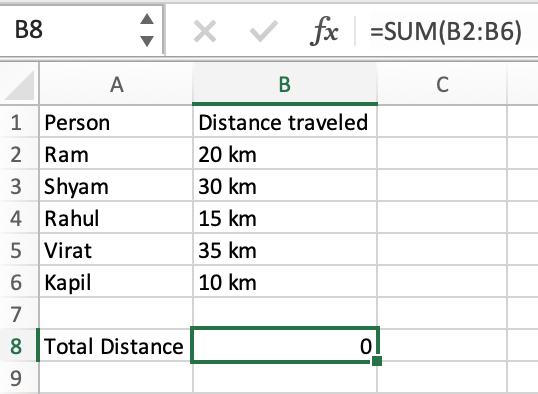5 Easy Ways to Sum Numbers in Excel

Microsoft Excel is an indispensable tool for anyone dealing with data, from businesses tracking their finances, students managing their grades, to analysts crunching numbers for insights. Among its many features, Excel excels at performing calculations, and summing numbers is one of the most frequently used operations. Whether you're calculating your monthly budget or analyzing financial data, knowing how to sum numbers efficiently in Excel can save you significant time and reduce errors. This blog post will guide you through five easy ways to sum numbers in Excel, helping you harness the full power of this versatile application.
Method 1: Using the SUM Function


The simplest way to sum numbers in Excel is by using the SUM function:
- Click on the cell where you want the sum to appear.
- Type
=SUM(followed by the range of cells you want to sum, likeA1:A10if you want to sum the first ten rows in column A. - Hit Enter, and Excel will display the total.
This method is straightforward, ideal for beginners or when you only need a basic sum.
💡 Note: Excel auto-suggests the SUM function when you type = in a cell, making it easier to use.
Method 2: The AutoSum Feature


For quick summing, Excel offers the AutoSum feature:
- Select the cell where you want the total to appear, preferably right below or to the right of your data range.
- Click the AutoSum button in the toolbar (Σ) or press Alt + =.
- Excel will suggest a range based on your data. If it’s correct, press Enter, or adjust the range manually.
The AutoSum feature saves time and anticipates the range you might want to sum, often proving accurate.
Method 3: Using Keyboard Shortcuts

If you’re aiming for speed, keyboard shortcuts can significantly enhance your Excel experience:
- Place your cursor in the cell where you want the sum.
- Press Alt + =. This is the same as selecting AutoSum, but quicker since you don’t need to move your hands from the keyboard.
- Excel will instantly sum the contiguous cells above or to the left, assuming you’ve got data there.
Keyboard shortcuts are for those looking to maximize efficiency, reducing mouse interaction, and allowing for quicker data entry.
Method 4: Subtotal Feature for Filtered Data


When working with filtered data, using the Subtotal feature can help:
- Sort your data by the column you want to filter.
- Filter your data based on your criteria.
- Select Subtotal from the Data tab.
- Choose Sum as the function, and select the column to apply the sum to.
- Excel will add rows with subtotal values for the visible (filtered) rows.
This method is excellent for when you need to get the sum of only the filtered data, keeping the context of your analysis intact.
📌 Note: Subtotal does not double-count data. If you reapply the filter, the subtotal updates to reflect the current visible data.
Method 5: Using the Status Bar

The Excel status bar provides a quick sum of selected cells without altering your worksheet:
- Select the cells you want to sum.
- Look at the bottom-right corner of the Excel window where the status bar is located.
- By default, the status bar will display the sum of the selected cells.
- If the sum isn’t showing, right-click the status bar, ensure Sum is checked.
This method is perfect for a quick check or when you want to see the sum without committing to a formula in your spreadsheet.
In summary, Excel offers various methods for summing numbers, each suited to different scenarios and user needs. From the basic SUM function for straightforward calculations to advanced features like Subtotal for filtered data, Excel caters to users at all skill levels. The AutoSum feature and keyboard shortcuts enhance productivity, while the status bar provides a non-invasive way to check totals. Knowing these methods not only increases efficiency but also empowers you to manipulate data more effectively in your spreadsheets.
What if I have non-numeric data in my range?

+
Excel ignores text values when summing numbers. If you want to flag or handle these, use functions like ISNUMBER() within an array formula or filter them out manually.
Can I sum values based on certain criteria?

+
Yes, you can use functions like SUMIF() or SUMIFS() for summing based on criteria. For example, =SUMIF(B1:B10, “>100”, A1:A10) sums numbers in A1:A10 where corresponding values in B1:B10 are greater than 100.
How do I sum across multiple sheets?

+
Use the SUM function with a 3D reference. For example, if you want to sum cell A1 from sheets 1 to 5, you’d write =SUM(Sheet1:Sheet5!A1).



